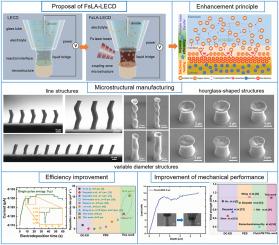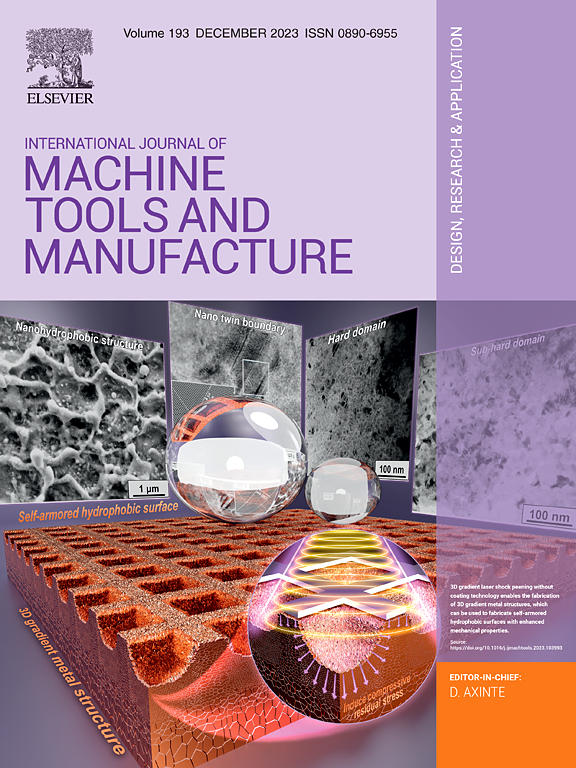A novel strategy for electrochemical additive manufacturing: Femtosecond laser-assisted localized electrochemical deposition
IF 18.8
1区 工程技术
Q1 ENGINEERING, MANUFACTURING
International Journal of Machine Tools & Manufacture
Pub Date : 2025-08-08
DOI:10.1016/j.ijmachtools.2025.104319
引用次数: 0
Abstract
Localized electrochemical deposition (LECD) exhibits significant advantages in fabricating microscale 3D metallic structures. However, conventional LECD technologies are inherently constrained by diffusion-controlled mechanisms, where pursuit of enhanced deposition efficiency inevitably degrades deposition quality (such as increased surface roughness and internal defects), consequently impairing structural mechanical properties. This study presents a femtosecond laser-assisted localized electrochemical deposition (FsLA-LECD) technology. By precisely coupling femtosecond laser irradiation with the electrodeposition microzone and leveraging laser energy to regulate electrodeposition process, this approach simultaneously achieves efficient fabrication of complex metallic microstructures with enhanced mechanical performance. The regulating effects of laser irradiation on mass transfer, nucleation kinetics, and grain growth evolution are investigated throughout the evolution process of point-surface-structure. Experimental and computational analysis elucidate that the laser-induced Marangoni effect within the reaction microenvironment enhances microzone electrolyte replenishment, consequently elevating deposition current density. This results in a volume deposition rate of 15.47 μm3/s, representing a 3 times enhancement over laser-free conditions. Laser-mediated regulation of deposition rates enabled fabrication of uniform-diameter, bamboo-like, and hourglass-shaped microstructures. Furthermore, pulsed laser energy facilitated stepwise current amplification, thereby inducing nanotwin formation within copper micro-geometrical features. This approach attained a tensile yield strength of 1.08 GPa, significantly surpassing that of traditional electrodeposited counterparts. This work demonstrates the capability of FsLA-LECD to simultaneously enable high-efficiency manufacturing and enhanced mechanical properties, establishing the groundwork for innovative approaches to high-performance micromanufacturing.

电化学增材制造的新策略:飞秒激光辅助局部电化学沉积
局部电化学沉积(LECD)在制造微尺度三维金属结构方面具有显著的优势。然而,传统的LECD技术本身就受到扩散控制机制的限制,在这种机制下,追求提高沉积效率不可避免地会降低沉积质量(如增加表面粗糙度和内部缺陷),从而损害结构力学性能。本研究提出了一种飞秒激光辅助定位电化学沉积(FsLA-LECD)技术。该方法通过将飞秒激光照射与电沉积微区精确耦合,利用激光能量调节电沉积过程,同时实现了复杂金属微结构的高效制造,并提高了机械性能。研究了激光辐照对点面结构演化过程中传质、成核动力学和晶粒生长演化的调控作用。实验和计算分析表明,反应微环境中激光诱导的马兰戈尼效应增强了微区电解质的补充,从而提高了沉积电流密度。这导致了15.47 μm3/s的体积沉积速率,比无激光条件下提高了3倍。激光介导的沉积速率调节使直径均匀,竹状和沙漏状微结构的制造成为可能。此外,脉冲激光能量促进了电流的逐步放大,从而在铜的微观几何特征中诱导纳米孪晶的形成。该方法获得了1.08 GPa的抗拉屈服强度,大大超过了传统电沉积的同类材料。这项工作证明了FsLA-LECD同时实现高效率制造和增强机械性能的能力,为高性能微制造的创新方法奠定了基础。
本文章由计算机程序翻译,如有差异,请以英文原文为准。
求助全文
约1分钟内获得全文
求助全文
来源期刊
CiteScore
25.70
自引率
10.00%
发文量
66
审稿时长
18 days
期刊介绍:
The International Journal of Machine Tools and Manufacture is dedicated to advancing scientific comprehension of the fundamental mechanics involved in processes and machines utilized in the manufacturing of engineering components. While the primary focus is on metals, the journal also explores applications in composites, ceramics, and other structural or functional materials. The coverage includes a diverse range of topics:
- Essential mechanics of processes involving material removal, accretion, and deformation, encompassing solid, semi-solid, or particulate forms.
- Significant scientific advancements in existing or new processes and machines.
- In-depth characterization of workpiece materials (structure/surfaces) through advanced techniques (e.g., SEM, EDS, TEM, EBSD, AES, Raman spectroscopy) to unveil new phenomenological aspects governing manufacturing processes.
- Tool design, utilization, and comprehensive studies of failure mechanisms.
- Innovative concepts of machine tools, fixtures, and tool holders supported by modeling and demonstrations relevant to manufacturing processes within the journal's scope.
- Novel scientific contributions exploring interactions between the machine tool, control system, software design, and processes.
- Studies elucidating specific mechanisms governing niche processes (e.g., ultra-high precision, nano/atomic level manufacturing with either mechanical or non-mechanical "tools").
- Innovative approaches, underpinned by thorough scientific analysis, addressing emerging or breakthrough processes (e.g., bio-inspired manufacturing) and/or applications (e.g., ultra-high precision optics).

 求助内容:
求助内容: 应助结果提醒方式:
应助结果提醒方式:


